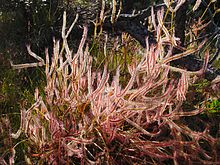Drosera subg. Phycopsis
| Drosera binata | |
|---|---|
 |
|
| Scientific classification | |
| Kingdom: | Plantae |
| (unranked): | Angiosperms |
| (unranked): | Eudicots |
| (unranked): | Core eudicots |
| Order: | Caryophyllales |
| Family: | Droseraceae |
| Genus: | Drosera |
| Subgenus: |
Phycopsis (Planch.) Schlauer |
| Species: | D. binata |
| Binomial name | |
|
Drosera binata Labill. |
|
| Synonyms | |
Drosera binata, commonly known as the forked sundew or fork-leaved sundew, is a large, perennial sundew native to Australia and New Zealand. The specific epithet is Latin for "having pairs" - a reference to the leaves, which are dichotomously divided or forked. This species occurs naturally in Australia, primarily in coastal areas from Fraser Island in Queensland, south down through New South Wales and Victoria to Tasmania and the south-east corner of South Australia. The range of this species extends to New Zealand where it is common below 1000 metres, being found in both the North and South Islands, Stewart Island/Rakiura and farther afield on the Chathams.D. binata is unique among sundews in having narrow, branching leaves. Some populations go dormant in the winter, while others are truly tropical.
It is the only species in the Drosera subgenus Phycopsis.
Plants similar to the type specimen, commonly referred to as the "T-form", were first collected in 1792 by the French exploration of Australia's southern coast led by Bruni d'Entrecasteaux. The naturalist on board that expedition, Jacques Labillardière, first described D. binata in his 1804 publication on the flora of Australia, Novae Hollandiae Plantarum Specimen. The T-form, so named for its single leaf bifurcation spreading into a T-shape, is a robust plant from temperate zones that can grow up to 30 cm (12 in) and has green foliage that becomes redder with age. This form has been described as being genetically stable.
...
Wikipedia
